KIA AMANTI 2006 Manual Online
Manufacturer: KIA, Model Year: 2006, Model line: AMANTI, Model: KIA AMANTI 2006Pages: 322, PDF Size: 44.16 MB
Page 81 of 322
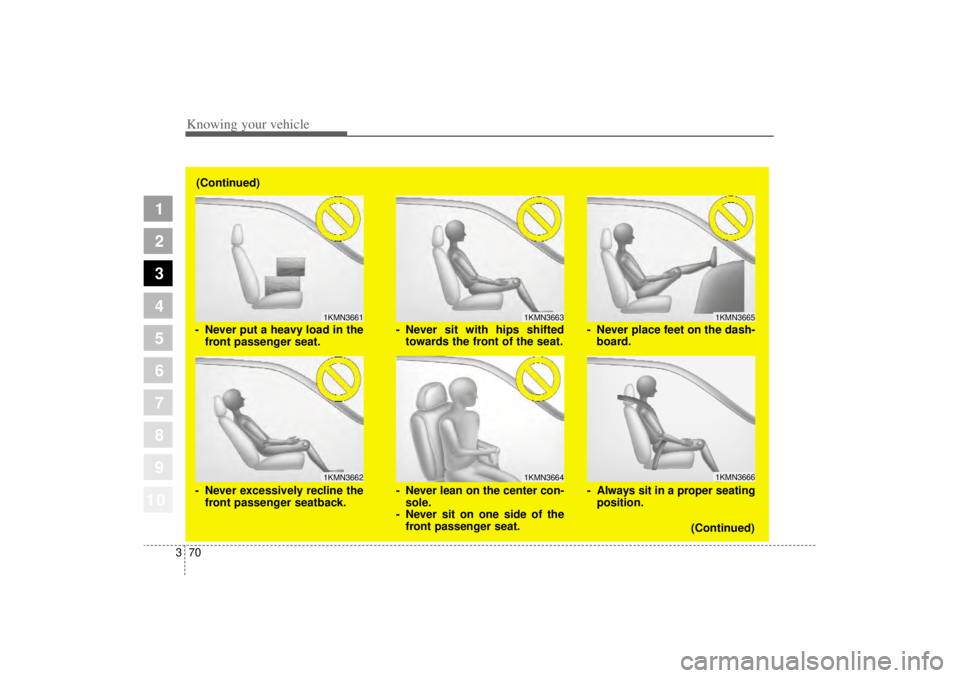
Knowing your vehicle70
3
1
2
3
4
5
6
7
8
910
1KMN36631KMN3664
1KMN36651KMN3666
- Never sit with hips shifted
towards the front of the seat.
- Never lean on the center con- sole.
- Never sit on one side of the front passenger seat. - Always sit in a proper seating
position.
- Never place feet on the dash-
board.
(Continued)
1KMN36611KMN3662
- Never put a heavy load in thefront passenger seat.
- Never excessively recline the front passenger seatback.
(Continued)
Page 82 of 322
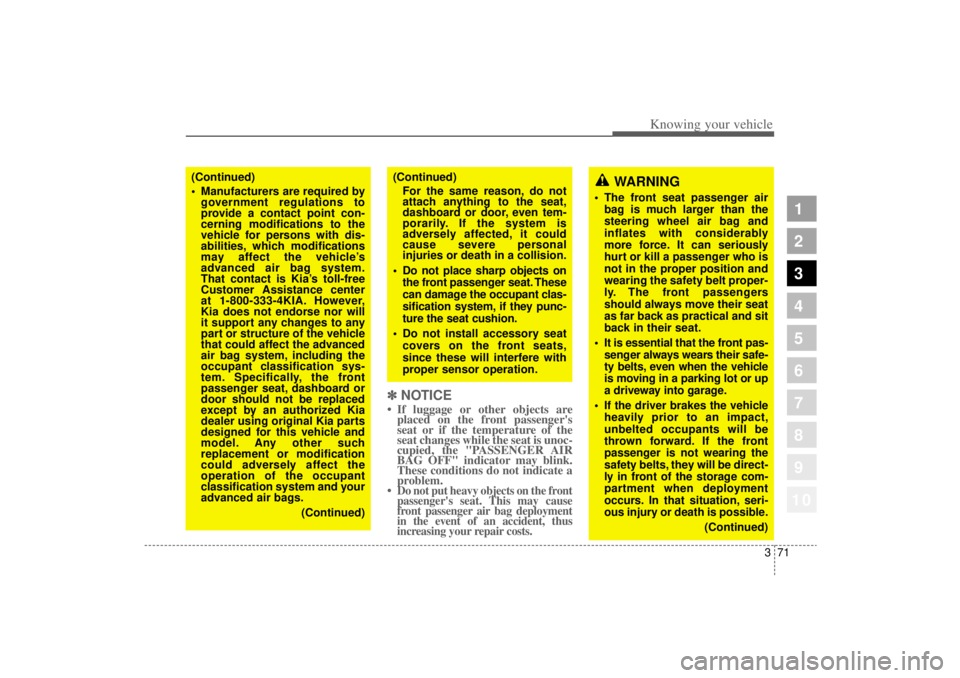
371
1
2
3
4
5
6
7
8
910
Knowing your vehicle
✽ ✽NOTICE• If luggage or other objects are
placed on the front passenger's
seat or if the temperature of the
seat changes while the seat is unoc-
cupied, the "PASSENGER AIR
BAG OFF" indicator may blink.
These conditions do not indicate a
problem.
•Do not put heavy objects on the front
passenger's seat. This may cause
front passenger air bag deployment
in the event of an accident, thus
increasing your repair costs.
WARNING
The front seat passenger air
bag is much larger than the
steering wheel air bag and
inflates with considerably
more force. It can seriously
hurt or kill a passenger who is
not in the proper position and
wearing the safety belt proper-
ly. The front passengers
should always move their seat
as far back as practical and sit
back in their seat.
It is essential that the front pas-
senger always wears their safe-
ty belts, even when the vehicle
is moving in a parking lot or up
a driveway into garage. If the driver brakes the vehicle
heavily prior to an impact,
unbelted occupants will be
thrown forward. If the front
passenger is not wearing the
safety belts, they will be direct-
ly in front of the storage com-
partment when deployment
occurs. In that situation, seri-
ous injury or death is possible.
(Continued)
(Continued)
Manufacturers are required by
government regulations to
provide a contact point con-
cerning modifications to the
vehicle for persons with dis-
abilities, which modifications
may affect the vehicle’ s
advanced air bag system.
That contact is Kia ’s toll-free
Customer Assistance center
at 1-800-333-4KIA. However,
Kia does not endorse nor will
it support any changes to any
part or structure of the vehicle
that could affect the advanced
air bag system, including the
occupant classification sys-
tem. Specifically, the front
passenger seat, dashboard or
door should not be replaced
except by an authorized Kia
dealer using original Kia parts
designed for this vehicle and
model. Any other such
replacement or modification
could adversely affect the
operation of the occupant
classification system and your
advanced air bags.
(Continued)
(Continued) For the same reason, do not
attach anything to the seat,
dashboard or door, even tem-
porarily. If the system is
adversely affected, it could
cause severe personal
injuries or death in a collision.
Do not place sharp objects on
the front passenger seat. These
can damage the occupant clas-
sification system, if they punc-
ture the seat cushion. Do not install accessory seat
covers on the front seats,
since these will interfere with
proper sensor operation.
Page 83 of 322
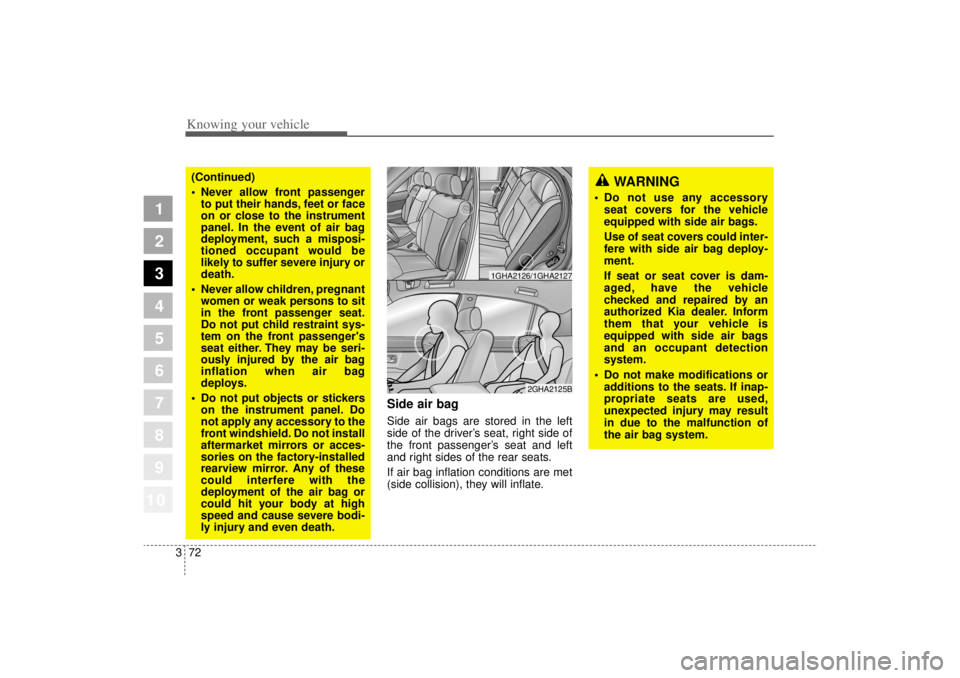
Knowing your vehicle72
3
1
2
3
4
5
6
7
8
910
Side air bagSide air bags are stored in the left
side of the driver’ s seat, right side of
the front passenger’ s seat and left
and right sides of the rear seats.
If air bag inflation conditions are met
(side collision), they will inflate.
WARNING
Do not use any accessory
seat covers for the vehicle
equipped with side air bags.
Use of seat covers could inter-
fere with side air bag deploy-
ment.
If seat or seat cover is dam-
aged, have the vehicle
checked and repaired by an
authorized Kia dealer. Inform
them that your vehicle is
equipped with side air bags
and an occupant detection
system.
Do not make modifications or
additions to the seats. If inap-
propriate seats are used,
unexpected injury may result
in due to the malfunction of
the air bag system.
2GHA2125B
1GHA2126/1GHA2127
(Continued)
Never allow front passenger
to put their hands, feet or face
on or close to the instrument
panel. In the event of air bag
deployment, such a misposi-
tioned occupant would be
likely to suffer severe injury or
death.
Never allow children, pregnant
women or weak persons to sit
in the front passenger seat.
Do not put child restraint sys-
tem on the front passenger's
seat either. They may be seri-
ously injured by the air bag
inflation when air bag
deploys.
Do not put objects or stickers
on the instrument panel. Do
not apply any accessory to the
front windshield. Do not install
aftermarket mirrors or acces-
sories on the factory-installed
rearview mirror. Any of these
could interfere with the
deployment of the air bag or
could hit your body at high
speed and cause severe bodi-
ly injury and even death.
Page 84 of 322
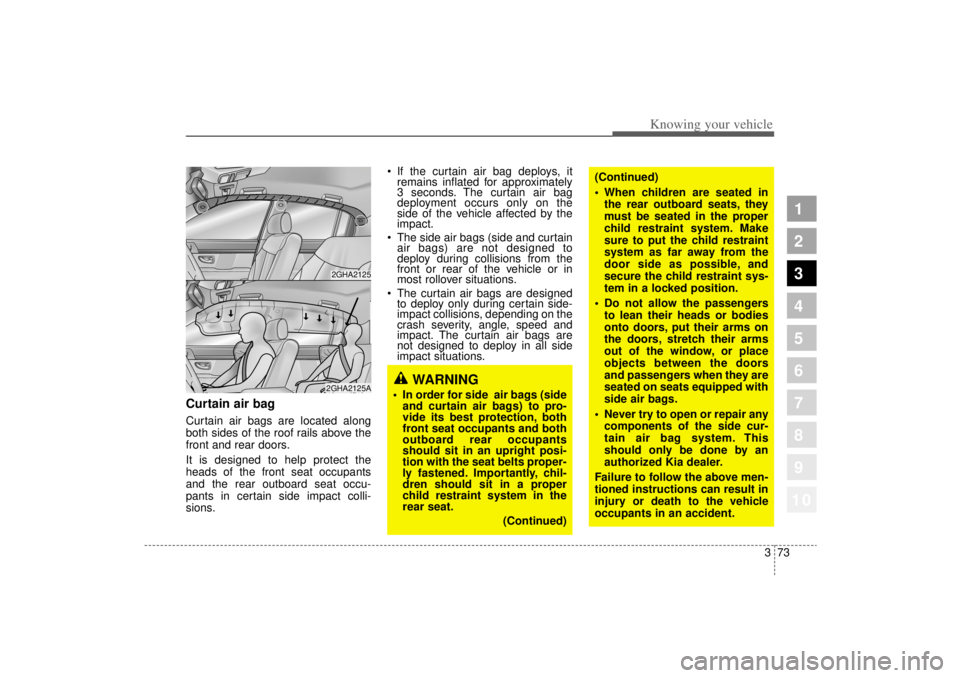
373
1
2
3
4
5
6
7
8
910
Knowing your vehicle
Curtain air bagCurtain air bags are located along
both sides of the roof rails above the
front and rear doors.
It is designed to help protect the
heads of the front seat occupants
and the rear outboard seat occu-
pants in certain side impact colli-
sions.
If the curtain air bag deploys, it
remains inflated for approximately
3 seconds. The curtain air bag
deployment occurs only on the
side of the vehicle affected by the
impact.
The side air bags (side and curtain
air bags) are not designed to
deploy during collisions from the
front or rear of the vehicle or in
most rollover situations.
The curtain air bags are designed
to deploy only during certain side-
impact collisions, depending on the
crash severity, angle, speed and
impact. The curtain air bags are
not designed to deploy in all side
impact situations.
WARNING
In order for side air bags (side
and curtain air bags) to pro-
vide its best protection, both
front seat occupants and both
outboard rear occupants
should sit in an upright posi-
tion with the seat belts proper-
ly fastened. Importantly, chil-
dren should sit in a proper
child restraint system in the
rear seat.
(Continued)
(Continued)
When children are seated in
the rear outboard seats, they
must be seated in the proper
child restraint system. Make
sure to put the child restraint
system as far away from the
door side as possible, and
secure the child restraint sys-
tem in a locked position.
Do not allow the passengers
to lean their heads or bodies
onto doors, put their arms on
the doors, stretch their arms
out of the window, or place
objects between the doors
and passengers when they are
seated on seats equipped with
side air bags.
Never try to open or repair any
components of the side cur-
tain air bag system. This
should only be done by an
authorized Kia dealer.
Failure to follow the above men-
tioned instructions can result in
injury or death to the vehicle
occupants in an accident.
2GHA21252GHA2125A
Page 85 of 322
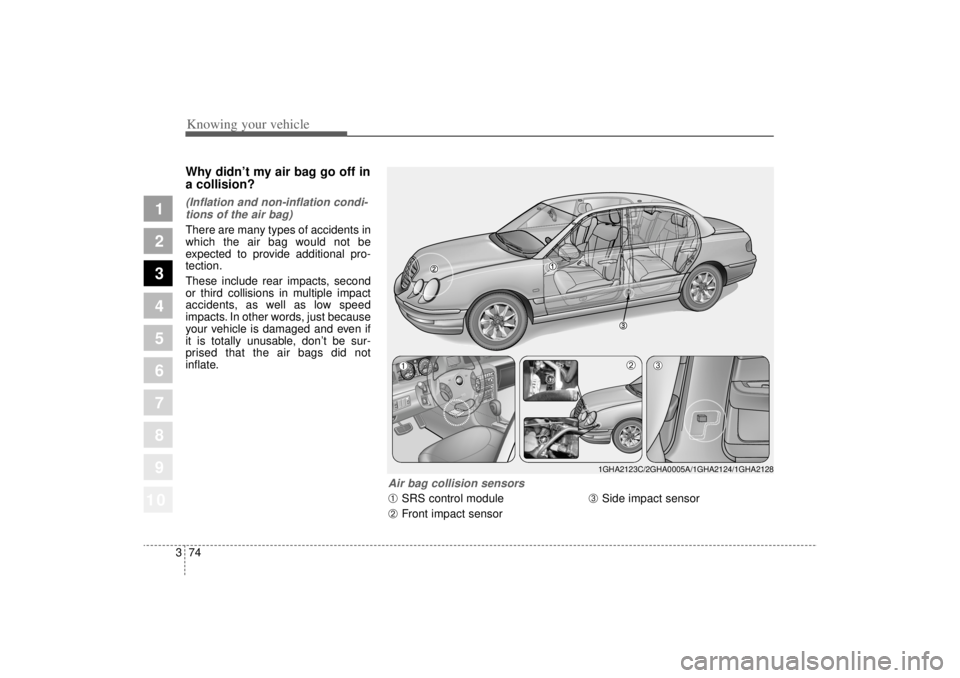
Knowing your vehicle74
3
1
2
3
4
5
6
7
8
910
Why didn’t my air bag go off in
a collision? (Inflation and non-inflation condi-
tions of the air bag)There are many types of accidents in
which the air bag would not be
expected to provide additional pro-
tection.
These include rear impacts, second
or third collisions in multiple impact
accidents, as well as low speed
impacts. In other words, just because
your vehicle is damaged and even if
it is totally unusable, don’t be sur-
prised that the air bags did not
inflate.
Air bag collision sensors➀
SRS control module
➁
Front impact sensor
➂
Side impact sensor
CRUISEON/OFFCANC EL
COO
ASTSTTCO
ACO
AT SE TETET S
E SRESAC CELAC
CELAC
CELC
CEL
1GHA2123C/2GHA0005A/1GHA2124/1GHA2128
➀
➁
➂
Page 86 of 322
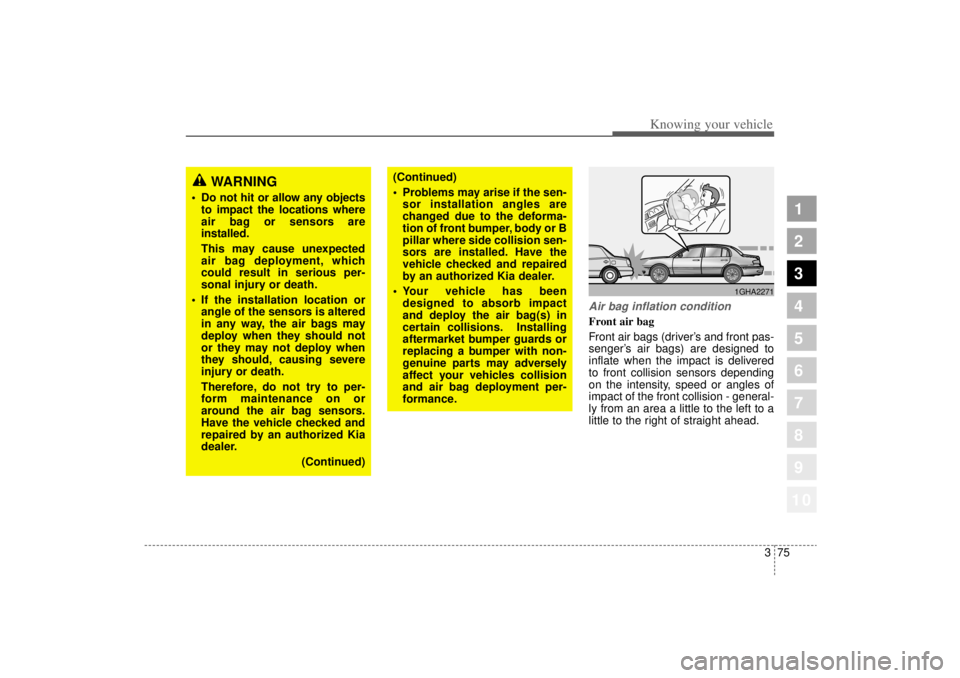
375
1
2
3
4
5
6
7
8
910
Knowing your vehicle
Air bag inflation conditionFront air bag
Front air bags (driver’s and front pas-
senger’ s air bags) are designed to
inflate when the impact is delivered
to front collision sensors depending
on the intensity, speed or angles of
impact of the front collision - general-
ly from an area a little to the left to a
little to the right of straight ahead.
WARNING
Do not hit or allow any objects
to impact the locations where
air bag or sensors are
installed.
This may cause unexpected
air bag deployment, which
could result in serious per-
sonal injury or death.
If the installation location or
angle of the sensors is altered
in any way, the air bags may
deploy when they should not
or they may not deploy when
they should, causing severe
injury or death.
Therefore, do not try to per-
form maintenance on or
around the air bag sensors.
Have the vehicle checked and
repaired by an authorized Kia
dealer.
(Continued)
(Continued)
Problems may arise if the sen-
sor installation angles are
changed due to the deforma-
tion of front bumper, body or B
pillar where side collision sen-
sors are installed. Have the
vehicle checked and repaired
by an authorized Kia dealer.
Your vehicle has been
designed to absorb impact
and deploy the air bag(s) in
certain collisions. Installing
aftermarket bumper guards or
replacing a bumper with non-
genuine parts may adversely
affect your vehicles collision
and air bag deployment per-
formance.
1GHA2271
Page 87 of 322
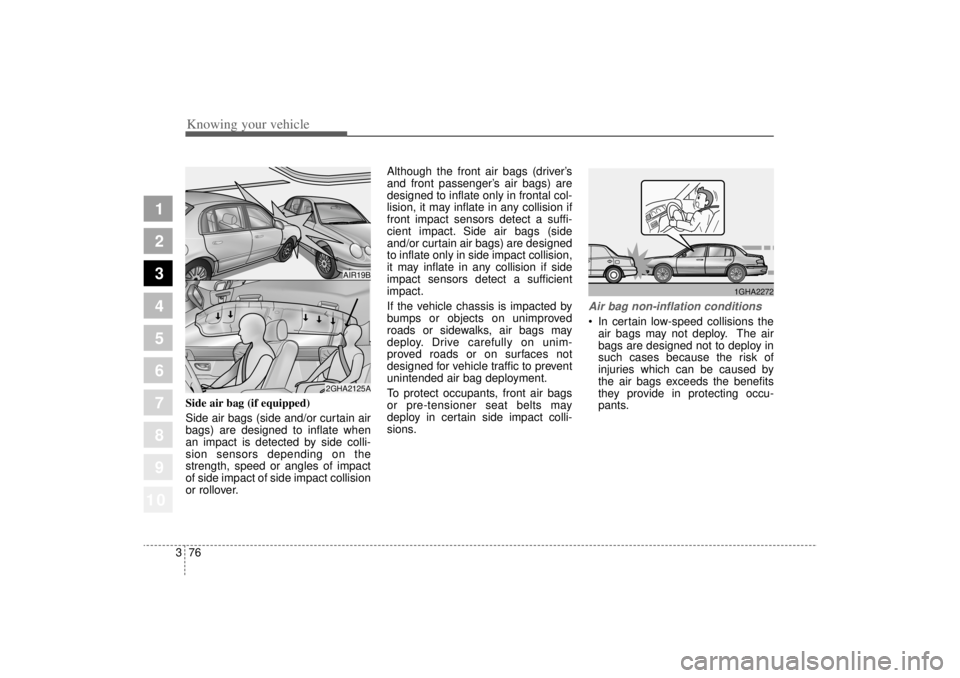
Knowing your vehicle76
3
1
2
3
4
5
6
7
8
910
Side air bag (if equipped)
Side air bags (side and/or curtain air
bags) are designed to inflate when
an impact is detected by side colli-
sion sensors depending on the
strength, speed or angles of impact
of side impact of side impact collision
or rollover. Although the front air bags (driver’
s
and front passenger’ s air bags) are
designed to inflate only in frontal col-
lision, it may inflate in any collision if
front impact sensors detect a suffi-
cient impact. Side air bags (side
and/or curtain air bags) are designed
to inflate only in side impact collision,
it may inflate in any collision if side
impact sensors detect a sufficient
impact.
If the vehicle chassis is impacted by
bumps or objects on unimproved
roads or sidewalks, air bags may
deploy. Drive carefully on unim-
proved roads or on surfaces not
designed for vehicle traffic to prevent
unintended air bag deployment.
To protect occupants, front air bags
or pre-tensioner seat belts may
deploy in certain side impact colli-
sions.
Air bag non-inflation conditions In certain low-speed collisions the
air bags may not deploy. The air
bags are designed not to deploy in
such cases because the risk of
injuries which can be caused by
the air bags exceeds the benefits
they provide in protecting occu-
pants.
AIR19B
2GHA2125A
1GHA2272
Page 88 of 322
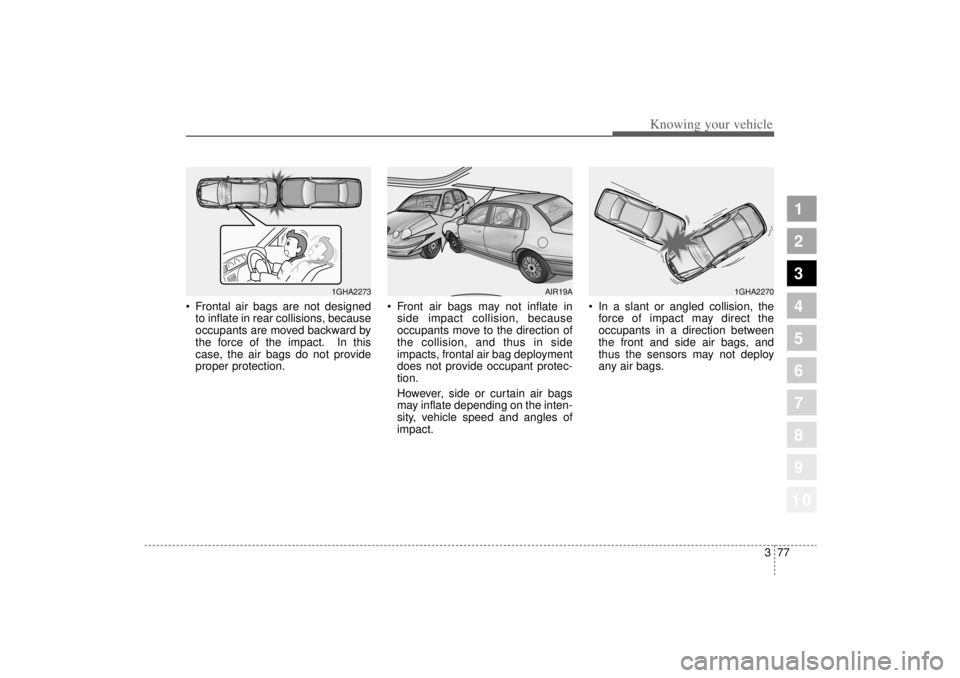
377
1
2
3
4
5
6
7
8
910
Knowing your vehicle
Frontal air bags are not designed
to inflate in rear collisions, because
occupants are moved backward by
the force of the impact. In this
case, the air bags do not provide
proper protection.
Front air bags may not inflate in
side impact collision, because
occupants move to the direction of
the collision, and thus in side
impacts, frontal air bag deployment
does not provide occupant protec-
tion.
However, side or curtain air bags
may inflate depending on the inten-
sity, vehicle speed and angles of
impact.
In a slant or angled collision, the
force of impact may direct the
occupants in a direction between
the front and side air bags, and
thus the sensors may not deploy
any air bags.
1GHA2273
AIR19A
1GHA2270
Page 89 of 322
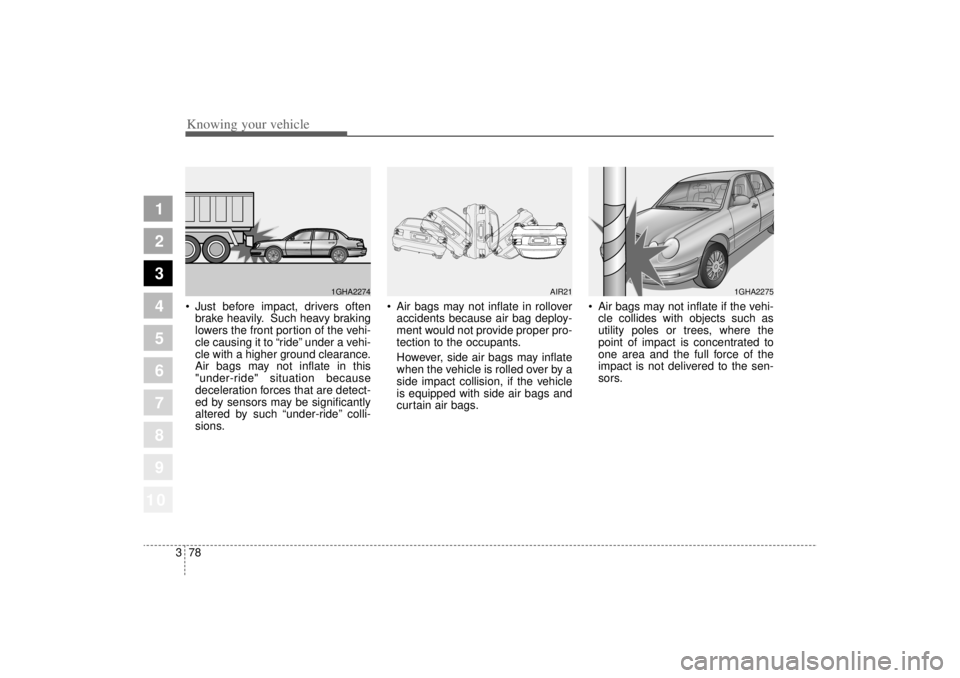
Knowing your vehicle78
3
1
2
3
4
5
6
7
8
910
Just before impact, drivers often
brake heavily. Such heavy braking
lowers the front portion of the vehi-
cle causing it to “ride”under a vehi-
cle with a higher ground clearance.
Air bags may not inflate in this
"under-ride" situation because
deceleration forces that are detect-
ed by sensors may be significantly
altered by such “under-ride”colli-
sions.
Air bags may not inflate in rollover
accidents because air bag deploy-
ment would not provide proper pro-
tection to the occupants.
However, side air bags may inflate
when the vehicle is rolled over by a
side impact collision, if the vehicle
is equipped with side air bags and
curtain air bags.
Air bags may not inflate if the vehi-
cle collides with objects such as
utility poles or trees, where the
point of impact is concentrated to
one area and the full force of the
impact is not delivered to the sen-
sors.
1GHA2274
AIR21
1GHA2275
Page 90 of 322

379
1
2
3
4
5
6
7
8
910
Knowing your vehicle
How does the air bag system
operate Air bag only operates when the
ignition switch is turned to the ON
or START positions.
Air bags inflate instantly in the
event of serious frontal or side col-
lision (if equipped with side air bag
or curtain air bag) in order to help
protect the occupants from serious
physical injury.
There is no single speed at which
the air bags will inflate.
Generally, air bags are designed to
inflate by the severity of a collision
and its direction. These two factors
determine whether the sensors
send out an electronic deploy-
ment/inflation signal.
Air bag deployment depends on a
number of factors including vehicle
speed, angles of impact and the
density and stiffness of the vehi-
cles or objects which your vehicle
hits in the collision. However, fac-
tors are not limited to those men-
tioned above.
The front air bags will completely
inflate and deflate in an instant.
It is virtually impossible for you to
see the air bags inflate during an
accident. It is much more likely that
you will simply see the deflated air
bags hanging out of their storage
compartments after the collision.
In order to help provide protection
in a severe collision, the air bags
must inflate rapidly. The speed of
air bag inflation is a consequence
of the extremely short time in which
a collision occurs and the need to
get the air bag between the occu-
pant and the vehicle structures
before the occupant impacts those
structures. This speed of inflation
reduces the risk of serious or life-
threatening injuries in a severe col-
lision and is thus a necessary part
of air bag design.
However, air bag inflation can also
cause injuries which normally can
include facial abrasions, bruises
and broken bones, and sometimes
more serious injuries because that
inflation speed also causes the air
bags to expand with a great deal
force.
There are even circumstances
under which contact with the
steering wheel air bag can cause
fatal injuries, especially if the
occupant is positioned exces-
sively close to the steering
wheel.